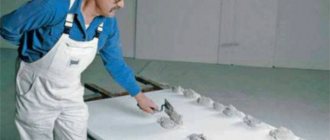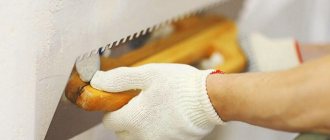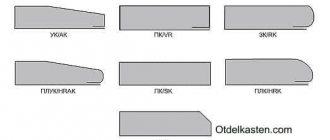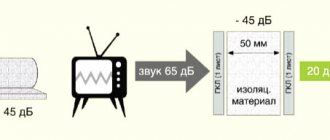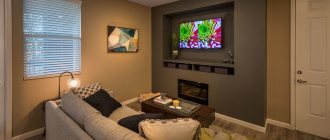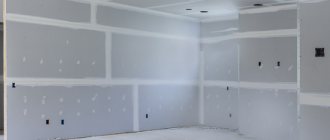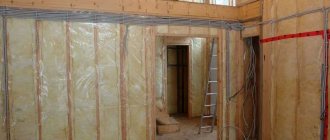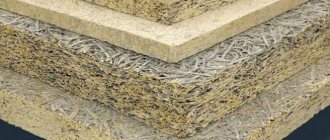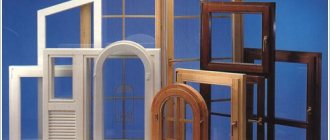Selection of soundproofing material
Different brands of plasterboard sheets have different soundproofing characteristics. The following sheets have maximum protection from extraneous noise:
- Knauf;
- Aku-Line;
- Volma;
- Magma.
The cost of the material is about 700 rubles per sheet.
Acoustic drywall is a sheet with a large number of holes. This design reflects sounds from the surface of the walls.
A soundproofed plasterboard partition is a multi-layer structure, for the installation of which materials with sound-proofing properties are used. This applies not only to drywall and filler, but also to framing and fasteners.
Materials for filling partitions
- Acoustic mats. A slab made of stone wool. The panel has a uniform surface, thanks to which sound waves are reflected from the surface. This material is environmentally friendly and safe.
Fiberglass based boards. The slabs are most in demand on the building materials market because they have a number of advantages:
- not subject to rotting processes;
- resistant to moisture;
- don't burn.
The sound insulation characteristics of the slabs are significantly higher than those of other materials.
Soundproofing material is presented in the form of sheets and rolls, the most popular are mineral, basalt and ecowool, felt.
Elastic materials that are mounted between supporting structures. The main function is to neutralize sounds from impacts.
Panels made of polyester and polyurethane foam. They are used to fill partitions and to install additional walls in the room.
In rare cases, the internal supporting surfaces are additionally glued with a backing made of cork or foil materials. However, in the case of plasterboard partitions, this option is ineffective.
Features of sound insulation of plasterboard partitions:
- The optimal choice is materials based on mineral wool.
- Foam is also used, but it only reduces the noise level and does not absorb it. Compared to other sound-absorbing materials, foam is ineffective.
- Sprayers are used as sound insulation - these are cellulose fibers impregnated with glue. During application to the surface, the thickness of the layer can be adjusted.
Choosing a soundproofing method
There are 2 ways to soundproof a room:
- lay soundproofing material, for example, mineral wool, in a special frame for drywall;
- use acoustic plasterboard sheets, sometimes a couple of layers are required.
Combined gypsum panels made of expanded polystyrene and glued gypsum plasterboard mats are suitable as insulating panels. They are applied to the leveled surface and then glued. You can’t do without vibration suspensions equipped with rubber gaskets; they instantly absorb the vibration that comes from the base.
You can use one of three methods for installing plasterboard soundproofing without using a metal frame.
- Gluing 2 layers of soundproofing plasterboard, for example, Silentboard, Diamond. The first coating is done according to the technology, and after the glue has completely dried, they move on to the second layer. The slabs are mounted so that the seams do not overlap the first layer. This will not achieve complete silence in the room, but the background noise will be reduced by half.
- Installation of gypsum panels using adhesive from the Knauf company.
- Gluing polystyrene foam. As soon as the glue has dried, a sheet of drywall is placed on top using self-tapping screws and foam. However, this option is also ineffective and does not completely protect against extraneous sounds.
We recommend: How to make a cork floor in the kitchen yourself
Materials required for independent soundproofing with plasterboard:
- damper tape - glued to guides, perforated profiles, which are fixed to the wall with self-tapping screws;
- mineral wool or other soundproofing product;
- vibration suspensions - mounted on rack profiles and dampen vibration coming from outside;
- membrane film.
Tools you will need:
- hammer;
- plane;
- metal scissors;
- drill, screwdriver;
- meter, level, ruler, pencil;
- construction knife;
- spatulas of different sizes.
Working step by step:
- Apply damper tape to the hangers and guide profiled sheets.
- Secure the metal plates with dowel nails.
- Strengthen the hangers at a distance of 40 cm from each other for the rack profile and fix it.
- To add rigidity to the structure, use “crabs” to fix the horizontal strips.
- Lay mineral wool, first placing a film under it - this will keep the material dry and increase the level of sound insulation.
- Make electrical wiring, run cables, hide the wires in the corrugation.
- Install plasterboard boards.
The service life of drywall depends on how carefully the joints are sealed after installing the slabs. Usually cracks and gaps are eliminated with putty and tape from Knauf. After the putty has completely dried, the surface of the sheets is primed, a finishing putty is applied, rubbed and treated with putty again.
Next comes the decorative finishing of the coating. It consists of the following steps:
- painting with waterproof paint to match;
- surface finishing with molding;
- applying liquid wallpaper or regular wallpaper on a vinyl or non-woven basis;
- decorative plastering;
- finishing with ceramic tiles;
- beautification with slabs.
Is it worth installing soundproofing in the ceiling?
A greater effect can be achieved if you make a floating floor in the room located above your head with a layer of insulation placed inside. This option is possible in a private house with a height of more than one floor. It makes sense to soundproof the ceiling in an apartment in compliance with all technology requirements. They will be described below.
How does a sound insulator prevent noise from entering a room? The noise can be impact - a mechanical impact on the ceiling (clattering heels, objects falling on the floor) and airborne (conversations, screams), also falling on obstacles that arise along the way. In this case - walls and floor. As a result, the person below hears noise that spreads along the supporting structures through their structure. Soundproofing material helps to partially absorb it. But it's not enough. It is necessary to lay a sealing tape where the ceiling adjoins the load-bearing foundations.
Requirements for soundproofing materials and ceiling construction:
- During transportation, the material must be reliably protected from moisture;
- Storage is carried out in dry rooms with a standardized level of humidity, in packaged form;
- To create a sound insulation layer, it is recommended to use mineral wool with a thickness of at least 4 cm or extruded polystyrene foam;
- To ensure better noise absorption at the junction of the profiles with the walls and sub-ceiling, it is necessary to lay a sealing tape, which is glued to the base of each profile.
How to increase noise absorption in addition to installing a layer of insulation?
You can “help” mineral wool or other material absorb noise by using some cladding tricks:
- Sheathing with two layers of gypsum board sheets. For a ceiling, such a solution is not always relevant, but it is possible taking into account a careful calculation of the weight of the structure, the thickness of the profiles, and components. One layer of gypsum plasterboard, 12.5 mm thick, increases sound insulation by 4 dts, 2 – by 8 dts;
- Increasing the space between the floor slabs and the new gypsum board base. The bigger it is, the better. The insulation can be laid in 2 layers. This solution is acceptable in rooms with a wall height of more than 2.7 meters;
- Make a ceiling without a strong connection to the wall - on hangers, seal the joints with sealant.
Sound insulation parameters
How comfortable it will be to be in the room in terms of the presence of external noise is determined by two parameters of the walls and partitions:
- Sound insulation index.
- Noise absorption coefficient.
The first characteristic determines how effectively the wall material prevents external sounds from entering the house. In this case, three types of noise are taken into account at once - those transmitted only through the air, those propagating through structural elements and vibrations. Effective technologies protect against all of them simultaneously.
In this case, the first one – spreading through the airspace – has the greatest degree of impact. For a comfortable stay, the sound insulation index value should be at least 54 dB for external walls and about 40-50 dB for interior plasterboard partitions.
The absorption coefficient determines the ability of the material structure to reduce external noise - up to complete damping. The parameter is measured from 0 to 1. The higher its value, the better the sound insulation.
Scheme of multi-component sound insulation of a wall Source remont-podkljuch.ru
The attenuation and reflection characteristics of sound waves in the same material are antagonistic. For this reason, to create an effective barrier to the propagation of sounds, the principle of multilayering is used - where reflective and absorbing layers cover each other.
What you will definitely need
Naturally, standard materials are needed to assemble the ceiling base - guides and ceiling profiles marked UD and CD, respectively.
For cladding, you can use ordinary plasterboard or moisture-resistant plasterboard, depending on the room where such a ceiling will be assembled. To assemble a complete soundproofing system, other materials are required.
- Firstly, you need high-quality sound-absorbing fillers for plasterboard sheathing. Most often, mineral wool slabs (can be of different thicknesses), polystyrene foam (polyurethane foam), various natural materials - peat, coconut shavings, cork, sound-absorbing synthetic membranes are used for these purposes.
- Secondly, do not forget that the frame itself, on which the casing will be attached, has the ability to vibrate due to vibrations, which means it is necessary to level out this factor. For this, insulating tape is used, which is mounted around the perimeter of the base, serving as a damper between the guide profiles and the load-bearing walls of the building. An important element of the soundproofing frame of a plasterboard suspended ceiling are vibration suspensions.
A special feature of vibration suspensions is the presence of a noise-absorbing element, which dampens vibrations transmitted from the walls and ceiling.
The most common option for a soundproofing ceiling is when sound insulation is provided by a filler made of mineral wool or polystyrene foam.
Mineral wool has many advantages. In addition to its thermal insulating properties, it can absorb up to 70% of noise vibrations. The only drawback of using such an insulator is that it “eats up” the space under the plasterboard sheathing, which makes it difficult to install spotlights. Polyurethane foam or polystyrene foam also dampens vibrations quite well, especially sounds such as steps, falling objects, and movement on the floor in the apartment from above. The only point in which the material is inferior to mineral wool is fire safety.
An example of laying soundproofing foam into a ceiling frame. It is also advisable to use a special sound-absorbing membrane for lining the filler. It is mounted on the ceiling before assembling the frame on the ceiling. And only then, for example, mineral wool slabs are laid on it.
It is not very convenient to use cotton wool in rolls; in any case, it will have to be cut into separate pieces in order to be placed in the frame of a suspended ceiling.
Otherwise, the materials and tools are the same as when assembling a conventional suspended ceiling. The assembly technology will differ only slightly with additions regarding the arrangement of the structure with noise-absorbing elements.
Relevance of using gypsum boards
Gypsum-based material can be used for various purposes. You can level the surface of a wall or ceiling, and with his participation complex frame structures are made. In addition, gypsum board is often used for sound insulation, because it is a good insulator.
Using drywall, you can create absolutely any structure that will meet all standards and quality requirements. If we talk about the relevance of the application, then we should not forget that the cost of this finishing option is much more profitable than ordering craftsmen to level the surfaces of the walls and ceiling.
Due to the lightness of the product, installation work can even be carried out independently. Today, the variety of design proposals from plasterboard structures is very large, and if there is a need, then anything can be done. Today, gypsum board sheets are one of the most popular and relevant building materials used in construction and repair.
Briefly about the advantages of bulkheads made of plasterboard sheets
Gypsum plasterboard sheets are deservedly in demand along with tongue-and-groove slabs when arranging housing. Bulkheads assembled from gypsum plasterboard have proven their positive qualities:
Affordable cost of system components. Light weight of the structure, which is important for apartment buildings. Simple installation and quick construction of walls. Environmental safety and durability.
If necessary, it is possible to use moisture or fire resistant sheets. Modern soundproofing materials based on fiberglass or mineral wool also comply with all environmental and fire safety standards.
Main manufacturers of gypsum boards
Drywall with improved soundproofing characteristics is produced by the following companies:
- Knauf is a German manufacturer known throughout the world that produces high-quality gypsum boards with optimal characteristics of strength, ductility and crack resistance. He constantly introduces innovative developments, improving the properties of the material, leaving competitors far behind. The cost of the product is high, but it is fully consistent with the quality.
- Gyproc is a French manufacturer that is focused on the European building materials market. Its product range is slightly worse than that of Knauf, but its prices are below the national average. In terms of technical characteristics, gypsum boards are slightly inferior to analogues from Knauf.
What not to do
In the absence of experience, mistakes can be made that can significantly damage the sound insulation of gypsum plasterboard walls. The first mistake is inappropriate materials, for example, polyurethane foam. It is not intended for soundproofing equipment and also does not meet fire safety standards. Polystyrene foam is also not very suitable for creating a noise-absorbing layer. This material is an excellent heat insulator and is intended primarily for insulating the walls of the facade of a building.
The process of soundproofing a wall with foam plastic
Exactly from the street side. Using expanded polystyrene inside an apartment or house can provoke a transfer of the dew point inside under the plasterboard sheathing, as a result the formation of mold is possible, since water vapor will condense in this place.
Soundproofing walls with polystyrene foam
Rolled materials, membranes or mineral wool are installed only overlapping; they should not form gaps at the joints between the individual panels.
If your financial situation does not allow you to completely soundproof your home yourself, you should not save or replace materials. It is better to arrange one room, for example a bedroom, for a more comfortable pastime. Using these recommendations, it’s quite easy to create a high-quality soundproofing pie. Which will help reduce noise in an apartment or house.
How to attach various objects to a frame partition
You can drive a nail or screw a self-tapping screw into a sheet of plasterboard sheathing. This mount will support the weight of a painting or mirror weighing up to 0.5 kg.
If you attach a hook to the sheathing with two self-tapping screws, then, depending on the thickness of the sheathing layer, you can hang an object weighing 2-6 kg on the hook. the distance between adjacent screws must be at least 30mm.
Expandable dowel at the top and DRIVA screw dowel at the bottom
To fasten heavier objects, such as bookshelves, to the casing, expandable or spiral dowels are used. There is no need to drill a hole for the spiral dowel. It screws directly into the sheathing sheet.
The permissible point load on a special anchor embedded in a sheet of plasterboard is no more than 20 kg. or 60 kg. for two-layer sheathing.
For installing heavier objects on the partition
in the places where they are attached, an additional frame profile should be installed, or a plywood panel should be fixed between adjacent frame posts under the sheathing (for example, to attach a wall-mounted boiler, heating boiler or washbasin).
Folding butterfly dowels embedded in a sheet of plasterboard can withstand point loads of up to 30 kg.
Next article:
We are building a house from aerated concrete. Gas silicate wall
Previous article:
There is formaldehyde in the house, the source is chipboard, OSB, plywood, insulation
Noise insulation. Soundproofing. Acoustic. Acoustic. Vibration isolation. Noise-absorbing, vibration-acoustic. Vibration resistant. Vibration-absorbing. Vibration dampening. Viscoelastic. GKL. Metal profile. Drywall
More articles on this topic
- Laying walls from aerated concrete and gas silicate blocks
- The thickness of the walls of a house made of aerated concrete - gas silicate
- How to connect electricity to your home
- Depth of seasonal soil freezing on the map
- Canopy, canopy for external door
- Prefabricated monolithic frequently ribbed floors made of light stone blocks
- Cheap shallow foundation for a house in a swamp
- Forced ventilation device in a private house
Which soundproofing material to choose
A plasterboard partition with high-quality sound insulation is a complex complex structure in which one or two insulating layers cannot be used.
You will need the correct choice of the drywall sheets themselves, the filling of the partition, frame materials and even fasteners.
So, the minimum set that will dampen up to 30% of noise includes:
- GKL (GKLV) PC plasterboard with a thickness of 9.5 or 12.5 mm - is arranged in two or three layers with gaps filled with sound-proofing material, with or without an air gap.
- The main soundproofing layer is sheet or roll material located in the spaces of the “pie”. The most widespread are: ecowool, basalt and mineral wool, felt or other substances.
- An additional soundproofing layer is used less frequently and involves gluing the internal supporting surfaces with cork, rubber-cork or foil backing. The backing is not very effective for plasterboard partitions.
- Frame – is a supporting structure, usually made of aluminum profile. Serves for fixing drywall.
Such an approach to soundproofing a partition will not bring the desired effect, even if the structure is made multilayer.
This is explained by the vibrational nature of sound waves, which propagate perfectly over communicating surfaces of high hardness. In this case, their role is played by the sheets themselves, the frame, and frame fastenings. The following measures will help reduce the impact of this chain:
- the use of OSB boards rather than plasterboard as an internal support sheet;
- the use of microporous rubber gaskets between sheet materials and the floor, ceiling, walls;
- gluing frame profiles with soundproofing tape materials;
- replacing the aluminum profile with timber made from durable types of wood, such as beech;
- installation of special soundproof dowels in the walls.
A correctly performed set of these actions will ensure at least 80% noise suppression, which means that voices, music at medium volume and the sound of moving furniture behind the partition will be almost inaudible.
Other technical specifications
According to the company's research, the greatest sound absorption occurs in the mid-frequency range in the range of 500-2000 Hz. In this interval, the absorption coefficient αw reaches a value of 0.85. The average coefficient αw for all types of panels is 0.55, and only for panels with diffuse perforation is it lower - 0.45.
All values of the αw coefficient are between 0 and 1. At αw = 1, the sound wave energy is completely absorbed, and at αw = 0 the sound wave is 100% reflected.
Ceiling with square cells
The dimensions of the acoustic plasterboard sheets differ from the dimensions of the usual one. The thickness of all panels is 12.5 mm. The remaining dimensions are different for all types of panels:
- The width of panels C1 is 1188 mm, C3 – 1197, B1 – 1224. The width of panels B2 and C2 are the same and equal to 1200 mm.
- The length of sheets C2 and C3 is 2000 mm, C1 – 1998 mm, B1 – 2448 mm, B2 – 2400.
Due to perforation, the weight of the sheets is small, from 8.8 to 9.6 kg.
Installation and soundproofing of plasterboard partitions
Protection against the penetration of extraneous sounds into the room during the construction of hollow and frame partitions increases significantly with an increase in the density and mass of the material used for the cladding, in our case it is gypsum board, as well as the sound-absorbing qualities of the layer and the width of the air space between the cladding.
- The construction of a false wall begins with markings on the floor or lower ceiling. Using a plumb line or a laser level (level), the lines are transferred to the ceiling and walls.
- According to the dimensions calculated during marking, the frame elements are cut.
- Guides for the frame of the structure are attached to the ceiling and floor; fastening is done with dowels, which are spaced in increments of no more than 100 cm. The frame is attached to the walls in the same way. To prevent the transfer of sounds and noise to the partition, an elastic strip, for example, polyurethane or cork tape, is laid between the surface of the floors and walls.
we are installing a frame for a future false wall made of gypsum plasterboard.
This popularity is due to the presence of polymer inserts in the suspensions, which dampen sound upon contact between metal parts.
- In the guide starting profiles (ceiling, floor), transverse posts are mounted and secured with self-tapping screws, the pitch is no more than 60 cm. When making single-layer plasterboard sheathing, the thickness of the sheet is 9.5 mm, to reduce the risk of damage to the plasterboard, the pitch between the posts is recommended to be reduced to 400 or 300 mm.
- Above the door openings, as well as at the joints and joints of the gypsum boards, additional frame racks are installed. A prerequisite is that the joints of the sheets are always placed on the profile. To impart the necessary rigidity to the structure, the racks around the door frame are reinforced by installing a wooden block inside the metal profile.
- Over the entire area of the sheet, using self-tapping screws, the sheathing sheet is fastened to the profile, a step of 25 cm. With a multi-layer structure, the fastener step must be increased, but not more than 60 cm, in this case the joints of the plates should be located in a running direction. The minimum permitted proximity of the location of screws to the edge (joint) of the canvas is 10 mm.
- When placing fastening elements (screws, self-tapping screws), it is necessary to ensure that they are screwed into the plasterboard board only at right angles, while penetrating into the metal studs by at least 10 cm.
We fasten the plasterboard sheets to the profile with self-tapping screws
- In order to allow the plasterboard sheet to expand and/or contract freely when humidity or temperature changes, it is recommended to leave technological gaps:
- ceiling and edge of the canvas - 5 mm;
- floor and trim – 10 mm;
- between 2 sheets with a straight edge – 6 mm;
- folded edge of the canvas - without gaps.
As a result, the gaps, depending on the size and location, are puttied or closed with reinforcing mesh and again covered with putty.
- After installation of the sheathing on one side is completed, the necessary communications are carried out in the internal space of the frame and sound insulation is placed between the sheathing posts. If the thickness of the mineral wool or slabs is less than the width of the profile, then its edges are inserted into the grooves of the racks, where they are additionally fixed with liners. When soundproofing plasterboard partitions, sound absorption boards can be glued to the inside of the frame.
- All communications, including electrical wiring, must pass through the gypsum board sheathing only in special elastic sleeves, for example, made of porous polyethylene or a similar material. This is done in order to eliminate the possibility of the formation of through cracks due to pipe displacement due to temperature changes. All pipes passing through the internal space of the false wall must be covered with the selected sound absorber, at least on one side.
- The final stage is the installation of the second side of the false wall.
In this case, the surface of the floating floor will come into contact with the wall structure only through the sound insulation elements. Thanks to this, the floor will not only serve as a kind of barrier from various sounds, but will also not transmit impact noise to adjacent rooms.
Installation features
An installation gap is left between the edges.
The technology for installing the frame is no different from installing the sheathing under ordinary sheets of cardboard. The changes concern the fastening of the panels themselves. They are fixed using a hidden method, with self-tapping screws screwed into the perforation holes. Before this, special plastic plugs are placed in the punctures.
Installation rules:
- material with the same characteristics and type of perforation is placed on one surface;
- the seams between the panels are puttied without installing a reinforcing mesh;
- An installation gap of 3 mm wide is left between the side edges of adjacent sheets, so that it can subsequently be sealed with putty.
GKL “acoustic” slabs with FC are not puttied, because the sides are joined using a curved edge. The sheets are placed so that the rows of perforations in adjacent sheets are at the same level.
Soundproofing of plasterboard partitions
Properly selected material for soundproofing plasterboard partitions is the key to peace and quiet. By protecting against intrusive conversations, music or TV in the next room, it helps maintain nerves and healthy relationships.
A typical modern interior partition is made of a wooden or metal frame covered with plasterboard on both sides. Such a wall does not resist the passage of sound well. If a similar redevelopment has been made in the apartment, then only soundproofing of plasterboard partitions will save you from noise.
Best materials
The most effective material that completely guarantees results does not yet exist and is unlikely to ever be made. There is also no universal, one-size-fits-all guide to follow when making a room barrier.
The effectiveness of activities depends on each stage. The very first is the installation of the frame. Its design will simply ring if you do not take protective measures - insulate the floor and ceiling from it. Without using a damper tape, it is impossible to achieve any significant results. An excellent damper is the proven Vibrostek-M tape.
As for the frame, there is not much to think about what to choose from - either wood or a metal profile. Their indicators are approximately the same, and little depends on the choice in favor of one or the other.
The panels covering the frame play a significant role. Acoustic plasterboard produced by Knauf or similar products from the Aku-Line line manufactured by Giprok can significantly reduce penetrating noise.
A responsible approach to the task requires that the sheets be laid in 2 layers. Just one layer does not give a quality result. Acoustic triplex, a specialized three-layer material for sound insulation, can also be used as sound insulation under drywall.
A good triplex is produced under the SOUNDLINE-dB brand.
The main role is played by the layer of aggregate laid between the panels. Sound-absorbing boards SCHUMANET-ECO have good performance and suitability for domestic use in apartments.
If the partition has already been built, there is not much to choose from. But it is not necessary to disassemble it and rebuild it. Sound absorption can be significantly improved by using wall membranes. Thanks to them, the volume of reflected sounds directed at the surface of the walls is reduced.
The process of installing sound insulation in a plasterboard partition
A good result depends not only on the materials, but also on how correctly and responsibly the sound insulation is done. Here we can highlight the following, most significant stages:
- Soundproofing a plasterboard wall in an apartment begins with mounting its frame on vibrating tape. It is laid in two layers, attached to the walls, floor and to each other with vibration sealant;
- Frame installation. It is advisable not to place sockets and switches on the future wall - sounds are transmitted very well through them. A rational solution would be to make the distances between the profiles correspond to the size of the soundproofing slab;
- Installation of plasterboard sheets of partitions on one side. Acoustic plasterboard is installed with perforations facing outwards;
- Laying sound-absorbing slabs in the interior partition. Their thickness determines what the thickness of the interior partitions will be;
- The final stage is when the slabs are covered with gypsum boards. To do everything correctly here, the joints need to be sealed with vibration sealant.
Briefly about the main thing
The sound insulation parameter of a wall or partition is the sum of the sound insulation index and the noise absorption coefficient. When organizing protective frames, you need to take into account that sound travels not only through the air, but also through building structures.
In order to improve the soundproofing capabilities of room partitions, the following techniques are used:
- Filling the frame cavities with filler.
- Increasing the thickness of the frame.
- Reducing crossbars.
- Use of special fasteners.
- Installation of a profile with special properties.
- Thickening of the cladding layer.
To maximize the sound insulation of plasterboard partitions, a special acoustic gypsum board is used, the cavities of the frame are filled with material with increased noise absorption characteristics, and the technology of spraying a sound-proof layer is used. When installing structures, it is necessary to follow technology and avoid mistakes.
Ratings 0
What are the advantages of the material and are there any disadvantages?
Gypsum fiber sheets, like other materials, have their advantages and disadvantages. The main disadvantage of GVL slabs is its cost. This material is currently somewhat more expensive than materials such as plasterboard, plywood, chipboard and MDF boards. Also among the disadvantages of the canvas is its significant weight
When making a frame, it is important to correctly calculate the strength indicator, since the mass of the slabs is considerable. As for the minuses, that’s probably all
Gypsum fiber has many advantages, which is why this material is often used in modern construction. Thanks to the hypoallergenic qualities of the finish, it can be used for residential premises and in particular children's rooms. The microporous structure of gypsum fiber sheets allows the walls to breathe, which helps protect the surface from fungal growth and mold.
Due to the hygroscopicity of the composition, the canvas can independently regulate the humidity of the apartment. If the apartment has high humidity, then the surface of the gypsum fiber board absorbs it. In case of increased levels of dryness, gypsum fiber releases moisture to create optimal climatic conditions. It is also worth mentioning the possibility of using GVL panels in rooms with temperature changes. Gypsum fiber sheet is an ideal material for finishing rooms without heating.
From the physics of the phenomenon to the understanding of technology
Physics of the phenomenon.
Behind every technological technique is knowledge of the laws of physics and hundreds of experiments. Therefore, in this section we have to understand the essence of the phenomenon and ways to dampen noise using the materials available in the modern construction arsenal. (see also the article Design of plasterboard ceilings: the imagination of designers is limitless)
Let's start with the school course.
- For those who have forgotten, let us remind you that sound travels in space in waves and, when it encounters an obstacle on its way, it is partially reflected and partially passes through it, losing its intensity. So far everything is familiar. In this case, the sound insulation characteristics are determined by the mass of the partition base, and to be absolutely precise, by the density (weight per square meter of the structure), and the greater the mass of 1 square meter of material, the better the sound insulation. That's physics. It would be possible to end here, but there is a nuance that is sometimes forgotten, sometimes ignored, but which will certainly manifest itself in practical application. We are talking about the intensity of sounds coming from various sources. The fact is that sounds can come both from outside and from neighboring rooms, while a person perceives the sounds of the street less painfully than sounds from neighboring rooms, even if they are less intense and loud than from the outside. But the solution to these problems is already in the plane of technology: different materials dampen sounds in their own way, and ordinary wall monopartitions are not able to fully absorb sound.
- This is how we smoothly move on to the technological features of this issue. According to construction canons, walls are laid out from materials that absorb noise, reducing their level to those established by building codes and regulations using a soundproofing index. At the same time, as a rule, in apartment buildings the walls and partitions are represented by single-layer structures, and in order to protect yourself as much as possible from the noise of the outside world, you need to independently build multi-layer walls (build them up). Here's a little more about this: Single-layer partitions are the painfully familiar walls of our apartments. Everything here is extremely simple: a brick or reinforced concrete slab and one or two layers of plaster (some lucky people get apartments without plaster). This example does not take into account the sound insulation properties of some soft materials. And calculations are made only for solid materials.
Sound absorption.
For your information! The noise insulation index of a brick wall will be approximately 45 dB, with a comfortable 62 dB calculated experimentally. To solve this problem, there are two ways: either increase the thickness of the wall with native material, which is practically impossible, or use plasterboard sheets and layered structures for sound absorption. But this is not only real, but we will also consider it in more detail in the next section.
- And about multilayer structures. At least two materials are involved in their formation, with the denser layer serving as a reflector, and the soft layer serving as an absorber of the sound that the hard layer cannot cope with.
Combinations of materials have proven to be ideal for solving this problem: hard - soft - hard. This is a practically solved problem. Sound passing through such a sandwich actually melts.
Puff pastry in section.
Drywall, is that you?
The sound insulation of plasterboard partitions perfectly illustrates the effect of a multi-layer cake, which is described in the previous section.
It’s worth talking about it in a little more detail.
- But before considering various techniques for improving sound insulation, I would like to introduce you to a rather interesting type of drywall. Acoustic drywall (shown in the photo).
Acoustic analogue.
- Both externally and structurally this type differs from its counterparts in the construction workshop. This material has a huge number of holes with a diameter of up to 1 cm evenly distributed over the entire area of the sheet. The inner side of the sheet is finished with a special soundproofing layer, reminiscent of spunbond in its structure, density and material. The principle of sound insulation is implemented as follows. The sound wave does not reflect from the walls, which would happen when using a regular sheet of plasterboard, but as it passes deeper, it loses its intensity on the non-woven fabric. Further, in the sound insulator layer, the sound almost completely dissolves, leaving only light sighs for the stationary walls. Naturally, such material is not only price-determining, but also has a limited scope. It is used in rooms where the noise source is inside rather than outside. These could be music classes and recording studios, places where singers and musical performers work. And, moving away from the muses, we inform you that this type of material is successfully used in boiler stations, pumping stations, workshops and other technical premises that use fairly noisy equipment.
For your information! This type of drywall is not puttied or covered with wallpaper; the best possible design is painting. And yet, this type of sound absorption is considered resonant.
Just paint.
The criteria have been determined, let's proceed with installation.
Drywall is a material that is more effective in sound insulation than even brick (although, of course, in terms of strength, brick will be preferable). The noise insulation of plasterboard partitions is 3 dB higher than that of brick ones.
Keeping the multi-layer cake in mind, let's get to work:
For your information! The technology, which will be described below, can solve several problems at once: reduce the noise level to almost zero, and also insulate the walls, which will be completely useful for owners of external apartments in high-rise buildings.
- The first stage is the installation of guide profiles . We hasten to reassure you: there are no additional requirements for the installation of these products, leveling, fastening and other technical delights. The profiles are also placed on the ceiling and floor along the perimeter of the wall, forming a single vertical plane, which can be determined by a rack profile inserted into the guides by applying a regular building level. And the dowels are fastened with guide profile nails every 40 cm. But then the variations begin, which will be useful for you to know about.
Whatever one may say, this is the first profile.
- Laying insulation . It can be carried out either independently, in a single layer, or during the installation of rack profiles. Let's consider both options. Firstly, you remember that the maximum effect of sound insulation is achieved by the method: hard - soft - hard. Having a rigid wall made of the material proposed by the builders, we need to cover it with softer insulation in such a way that the sound insulation of the plasterboard partitions has a maximum value. In this case, it is this layer that will scatter sound waves. Here, theoretically, both mineral wool and fiberglass wool can be used. When choosing these materials, remember that you are solving not one, but two problems, so the material must: have minimal thermal conductivity;
- absorb sound in the best possible way, so that the sound insulation in plasterboard partitions is maximum;
- be sufficiently strong and durable;
- have minimal water absorption;
- easy to install on the wall.
Insulation and sound insulation are lovebird criteria.
- Yes, both presented materials, to a greater or lesser extent, possess these qualities, but there are disadvantages that should not be kept silent about, but it is still worth thinking about the necessity and possibility of application. Mineral wool “breathes” perfectly, which allows it to perfectly absorb moisture like a sponge, so any insulation or soundproofing work with this material requires the installation of a water barrier. A hydrobarrier is a film whose structure and density resembles a film for greenhouses. It is also used for fiberglass wool. Otherwise, fiberglass, let’s be honest, and mineral wool will create the conditions that the fungus loves so much: heat and moisture. (see also the article Repairing the ceiling with plasterboard: the experience of professional craftsmen)
- Expanded polystyrene can completely solve the moisture problem . An interesting and promising material, it will not let water vapor inside. The only condition that must be met is correct docking. But the manufacturers thought about this too. Currently, rolls of expanded polystyrene are produced with a ready-made stepped, joining edge, just like in childhood with appliques, combine and glue - it’s simple. Let us once again praise the material, but let us inform you that it is not soundproofing at all.
Expanded polystyrene.
Advice! Don’t be discouraged, what seemed fantastic yesterday allows us to make coffee today. What we mean is that materials have now appeared that, thanks to their impregnation, make it possible to solve these problems in the right way. One well-known company, Knauf, produces a whole range of insulation materials with soundproofing properties. Yes, you will have to pay for branded products, but it will be worth it.
Option for placing insulation.
- So, the installation itself is carried out against the wall . The material is fixed with special fasteners, which are simply called umbrellas. There is no single installation standard (meaning the gap between products), but the main criterion is the absence of sagging of the material, and use it as a guide. It is allowed to lay the material when direct fastenings for rack profiles are already installed. In this case, cuts are made in the insulation for these fastenings. The second installation method also has its own logic; when working with a high-speed hammer drill, the soft insulation material can be screwed onto the drill, the base will be damaged and, in fact, the material itself will be damaged. Therefore, in order to avoid negative emotions with the mention of someone’s mother, we recommend the second method of laying insulation.
Umbrellas.
- Next comes the installation and fixation of direct fasteners on vertical lines . There are no additional innovations here either. The rack profile is fixed every 60 cm, with a pitch of the profile itself from 40 to 60 cm when calculating on the material for the subsequent design of plasterboard walls.
- The sheathing is installed . We install plasterboard sheets. Fastening is done in the same way, with metal screws around the perimeter and in the center to the profiles.
- Then the primer-putty complex with all the ensuing technological aspects (see also the article Finishing putty for drywall - all the main points).
Reminder! Working at this stage requires drying of each previous stage. We primed, waited, went over the starting putty, waited for it to dry, and so on until the end, until the last drop of primer on the wall, waiting for it to dry.
- The result of applying the technology for laying and finishing plasterboard sheets should lead us to two equivalent results: First, the room has perfectly smooth walls;
- Secondly, soundproofing a plasterboard partition allows you to enjoy silence or minimal sound from neighborly feuds or fun.
Hey, neighbors, I can't hear you
A few final tips
It is believed that the installation of plasterboard structures and the presence of a layer of air is the very necessary “soft” layer that will dampen sound. Of course, air cannot be called solid, but you will not get a noticeable effect from the air gap.
Therefore, there is a very simple and at the same time effective way to enhance sound suppression. Remember, at the beginning of the material we talked about doubling the partition; when carrying out repair work, of course, you will not install a second layer of brick. Firstly, the structure is significantly heavier, and secondly, all this is expensive.
But there is a way out - a second layer of drywall. The price of the project is the price of plasterboard sheets + metal screws. We have already written that the sound insulation of plasterboard is higher than that of a brick wall, and the sound insulation of partitions made of two layers of plasterboard is even higher.
In two layers.
Features of acoustic drywall
The words “acoustic” and “acoustic” when applied to building materials usually tell us that the material has soundproofing or sound-absorbing properties. For example, acoustic mineral wool, soundproofing panels for walls or rolled soundproofing material in the form of a membrane can reduce the noise level in the room by preventing sounds from outside and from neighboring apartments. But acoustic drywall is not on a par with these materials.
This error has crept into many construction sites and portals and misleads people, but if you open the section about Knauf Acoustics slabs on the official website, you will not see a word about the fact that this is a soundproofing material.
Why then do we need acoustic drywall? This material is used to improve the acoustic characteristics of a room. This means that he:
- reduces the level of background noise occurring in the room itself;
- reduces boominess;
- eliminates the “echo” effect;
- allows you to improve speech perception.
Thus, according to Knauf Acoustics itself, plasterboard allows you to create a comfortable acoustic environment in any room, which is especially important for objects with increased requirements for it:
- in recording studios;
- in music classes, concert and rehearsal halls;
- in cinemas;
- in meeting rooms;
- in classrooms.
The acoustic variety of gypsum boards also has a place in the apartment. It will help solve the problem of booming that is typical in some rooms, and will be appreciated by music lovers, musicians playing at home, as well as home theater owners.
Why is drywall soundproofing needed?
These works are carried out in order to eliminate the risks of acoustic resonance (maximum high when plasterboard is rigidly tied to building structures) and protect against external noise, including:
- Airborne noise - barking neighbors' dogs, snatches of conversations, children's crying, music, street sounds.
- Structural noise that occurs during the operation of boilers, washing machines, elevators or any other vibration equipment.
- Impact noises - stomping feet, hammering.
Sound insulation of plasterboard walls should not be confused with the internal installation of sound-absorbing materials (in particular, perforated acoustic plasterboard cladding and work to improve the background characteristics in rooms with music systems or home theaters). Soundproofing drywall is aimed primarily at protecting against external noise, rather than improving the situation of neighbors.
Tips for achieving the best soundproofing results under drywall.
- You should follow the technique of layer-by-layer penetration of noise through layers, and then the sound insulation of plasterboard partitions will pay off. All fasteners and structural elements must be installed with soundproofing gaskets.
- The sound insulation effect will be greater if you mount two separate frames, onto which the sheathing will subsequently be attached.
- Sheathing should be selected taking into account the required absorption coefficient Rw - a conditional characteristic that reflects the relationship between the soundproofing parameters of materials and noise in an apartment or on the street. It is better to choose such a coefficient from 0.8 and above.
- The soft layer material should not be less than 100 mm. As a percentage, it should not be less than 50% of the volume of the soundproofing partition.
- Acoustic mineral wool can be placed between the gypsum board frames to create a damping effect. In this case, the sound insulation coefficient increases by reducing the resonance effect in the partition.
- It is necessary to achieve complete tightness of the structures. Avoid any mechanical deformations, holes and cracks. Caulk the joints using a shock-absorbing mesh. Use silicone sealant in areas where electrical wiring and other communications are carried out. Polyurethane foam is not suitable due to its flammability.
A significant effect of sound insulation of interior walls (approximately 30 dB) can be achieved using sound-absorbing membranes. Such elements are attached to the inside of the structure using glue. Soundproofing under drywall - there is no more ideal and justifiable way to protect against noise.
Soundproofing panels instead of drywall
It was noted above in the article that covering the frame with a double or even triple layer of sheets on one, or better yet, on both sides improves the sound insulation of the partition. Moreover, it is more effective to use multi-layer and massive cladding sheets.
Soundproofing panel 12 mm thick. from corrugated cardboard. The cavities in the panel are filled with vibration-compacted quartz sand.
Soundproofing panels made of special corrugated cardboard have appeared on the construction market, which are convenient and profitable to use for covering frame partitions as a bottom layer. The panels are sold under different brands.
The panel design contains alternating layers of materials with different acoustic properties. This ensures multiple reflection and scattering of sound waves. The friction of sand grains under the influence of sound waves further reduces the sound energy.
The large weight of soundproofing panels allows them to effectively reduce noise, including at low frequencies.
Dimensions of one panel are 1200 x 800 (600) mm, thickness 8-22 mm. and weight 10.5 - 21 kg. The panels can be easily sawed with a hand saw or power tool. When sawing, slight spillage of filler may occur. The edge of the cut is covered with construction tape. Panel weight 12 mm thick. equal to 19.6 kg. (19.7 kg/m2)
Soundproofing a frame partition with soundproofing panels made of corrugated cardboard
The panels are fixed to the frame using self-tapping screws. After installation, the joints of the panels are puttied and taped. Sheets of plasterboard are glued to the panels with mounting adhesive in increments of 300 x 300 mm. and are additionally secured directly to the panels with self-tapping screws in increments of 400 mm.
Frequency response of sound insulation of a frame partition.
The figure shows the frequency response of sound insulation of a frame partition. Light green shows the characteristics of a partition made of PS 50/50 profile with the frame filled with acoustic mineral wool and sheathed with 12.5 mm thick plasterboard sheets. in one layer on each side. The dark green color shows an increase in the sound insulation of the partition if the partition is sheathed on one side with sheets in two layers. Moreover, soundproofing panels made of corrugated cardboard 12 mm thick should be used as the bottom layer.
Watch the educational film “Installation of a plasterboard partition.”
In addition, you can view and download:
- A guide to installing Knauf soundproofing partitions, floors, ceilings and cladding is here ;
- A guide to installing plasterboard partitions on a metal frame is here ;
- A guide to installing plasterboard partitions on a wooden frame is here .
Features of working with Knauf Acoustics panels
When working with acoustic gypsum boards, you need to remember some important points:
The joints of 4PK panels are puttied without the use of reinforcing tape. The edges are pre-cut with a slight bevel, the panels are mounted with a gap of 3–4 mm. The seams will be filled with Uniflot putty, and the recesses from the screws will be filled with putty. After drying, the seams are puttied with finishing putty and sanded.
- The connection of 4FK panels does not require additional processing, since the joining is carried out using folds.
- Arched structures are made using dry and wet bending methods using plywood templates.
Finishing a plasterboard partition
The joints of plasterboard sheets with a profiled edge and the junctions with the walls are filled with special gypsum putty. A fiberglass mesh reinforcing tape is embedded into the layer of putty along the joint.
The recesses in the places where the self-tapping screws are installed are also filled with putty. After the putty has dried, the surface of the joints is sanded. Provided the joints are carefully finished, the entire surface of the sheets does not need to be puttied.
After sealing the joints, walls sheathed with sheets with a rectangular edge are covered with a continuous layer (2-3 mm) of finishing putty. To fill joints, use putty recommended by the manufacturer
purchased plasterboards. Manufacturers select the composition of the putty in such a way that, if the technology for installing the structure and sealing the seams is followed, the joint will be strong and durable.
You should not use materials that are not intended for this purpose for filling joints, for example, compositions for thin-layer finishing surface filling. Under no circumstances should such a replacement be made, since such compositions do not have sufficient strength - subsequently the seams will almost certainly crack.
At the corners of the partitions, a special metal corner profile is embedded in a layer of putty, which strengthens the corner.
It should be taken into account that microcracks may appear over time at the joints of sheets, which are difficult to disguise by painting. Therefore, for finishing plasterboard partitions, it is safer to use wallpaper, tiles or other types of finishing that are not sensitive to microcracks in the base.
Main characteristics
Now let’s find out why Knauf Acoustics slabs have the above properties.
- Perforation on the surface. Many through holes act as resonators, providing sound absorption. As a result, sound waves quickly attenuate, falling into a kind of trap.
- The non-woven fabric on the back side also has sound-absorbing properties. Depending on the design, you can choose gypsum boards with black or white non-woven fabric.
Acoustic gypsum board "Knauf" has several options for the location and shape of holes, by which the material model is determined:
- With continuous perforation. On this model, the holes are distributed evenly over the entire surface.
- With block perforation. The holes are located on the plane in separate groups.
- With round perforation in the form of holes with a diameter of 0.8 cm.
- With square perforation, where the holes are made in the shape of a square with a side of 1.2 cm.
- With scattered round perforation - the holes on the surface are located in a chaotic manner and have different sizes - 0.8 cm, 1.5 cm and 2 cm.
Types of edges
Plasterboard acoustic panels are available with two types of primed edges:
- Curly (rebated) in the form of a step. Designated FC.
- Straight (PC).
The sheet can have the same type of edge around the perimeter, or it can have 2 folded and 2 straight edges. On the sheet they are located in pairs on opposite sides.
Types of edges
Accordingly, panels according to the type of edges come in 3 types:
- All edges are straight (4pcs).
- 2 straight, 2 folded (2PK/2FK).
- All folded (4FK).
The longitudinal edges on one sheet of 4pcs are painted blue and red. This was done so that during installation the master could easily control the joining of the blue edge of one sheet with the red edge of another. In this case, the chamfers on the front side form a smooth groove at the joint.
To install one plane, sheets are taken not only with the same design, but also with the same type of edges.
Necessary materials
Plasterboard walls are created on the basis of a frame made of metal profiles, but when creating sound insulation with your own hands, this will not be enough.
Diagram of a noise-absorbing device for a plasterboard wall
Other materials will also be required:
- A damper tape must be installed under the guide profiles (for example, soundproofing tape “Dichtung”). It will absorb vibrations transmitted from the wall to the frame. You can also use its analogue, fiberglass spatula tape;
- Another element of the frame when creating soundproof walls will be vibration suspensions. This is a modified type of direct suspensions with a noise-absorbing element. They, like the tape, absorb vibrations transmitted from the wall to the frame;
- As the main sound insulator, you need to choose mineral wool, which has excellent vibration absorption qualities. You can also use felt or cork;
- Additionally, a membrane film can be laid under the frame, which has the ability to reduce the penetration of sounds.
This is what a plastic dowel looks like
. In addition to these materials, it is worth purchasing plastic dowels, which resist vibrations better than metal ones.
And don’t forget about switches and sockets in drywall; they also conduct sound well; they must be insulated with rubber pads in the form of washers.
What you need to install an acoustic suspended ceiling
To install a suspended sound-absorbing ceiling, you will need the same tools as for working with regular drywall:
- Roulette, level.
- Metal scissors, grinder.
- Knife for HA, narrow spatula.
- Hammer drill, screwdriver or drill driver.
- An empty plastic tube of acrylic liquid nails and a plunger gun.
- Hand grater with a set of fine mesh for grinding.
As you can see, wide spatulas will not be needed in this case, since when installing perforated HA, putty work is limited only to sealing the seams and screw heads. Due to the absence of the labor-intensive and messy stage of finishing putty, the entire installation process proceeds much faster.
The supporting frame is mounted from standard metal profiles, which are used to work with ordinary drywall.
Frame design
When assembling the frame, in addition to the usual direct suspension, you will need vernier suspensions, combined suspensions and two-level connectors.
How to increase the effectiveness of sound insulation using gypsum plasterboard?
When designing partitions made of plasterboard sheets, to improve the quality of sound insulation, you must adhere to the following rules:
- It is recommended to use two independent frames for attaching gypsum boards to ensure acoustic decoupling due to the absence of rigid connections.
- The sheets must be secured to the frame using elastic fasteners.
- The cladding should be selected with the maximum possible thickness and weight, but from flexible materials to ensure maximum attenuation of sound vibrations transmitted through the air.
- Use soundproofing profiles.
- Partitions should be made with two layers of gypsum plasterboard.
